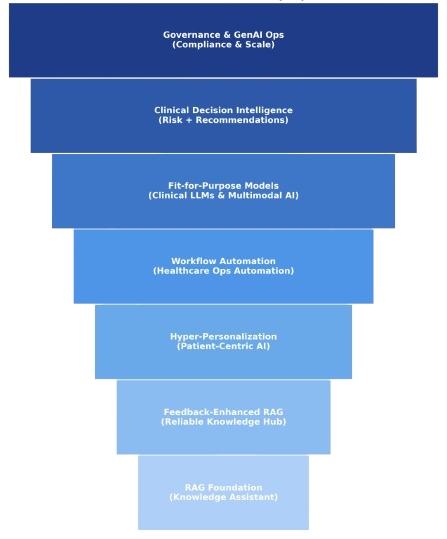
Generative AI (GenAI) has the potential to transform healthcare delivery, from reducing clinician burnout to empowering patients with better experiences. Yet, most HealthTech organizations face a dilemma:
How do we move from pilots and proof-of-concepts (POCs) to scalable, production-grade GenAI systems that are safe, compliant, and effective?
At 10decoders, we’ve seen a clear adoption pattern. Instead of fragmented pilots, healthtech leaders need a structured playbook that balances quick wins with long-term scalability—while meeting HIPAA and regulatory requirements.
In this blog, we present a 7-step playbook that shows how healthcare enterprises can start with retrieval-based assistants and scale all the way to personalized, compliant, and decision-ready AI systems.
Why HealthTech Struggles with GenAI Adoption
- Compliance Complexity: Data must stay HIPAA-compliant, de-identified, and audit-ready.
- Fragmented Systems: EMRs, lab reports, insurance documents, and patient data live in silos.
- Clinical Safety: AI errors can impact lives—so guardrails and human oversight are critical.
- POC Fatigue: Hospitals and startups build demos but fail to scale to enterprise-wide adoption.
The solution: A systematic playbook that brings healthcare data, personalization, and workflow automation into one GenAI strategy.
The 7-Step Playbook for Building GenAI Use Cases in HealthTech
Step 1: Start with a RAG Foundation
- Consolidate EMR data, discharge summaries, and clinical protocols into a GenAI Drive.
- Provide semantic search and medical FAQ assistants for staff and patients.
- A hospital chatbot that answers questions about insurance coverage or pre-surgery prep.
Step 2: Mature the RAG Layer with Continuous Feedback
Make the RAG assistant clinically reliable.
- Introduce clinician feedback loops to refine answers.
- Enhance embeddings with medical ontologies (SNOMED CT, ICD-10, UMLS).
- Add monitoring dashboards for accuracy, latency, and compliance audit trails.
- Nurses correcting and validating discharge instructions improves GenAI accuracy over time.
Outcome: A trustworthy medical knowledge hub, continuously improving with clinical validation.
Step 3: Introduce Hyper-Personalization
Deliver AI that adapts to each patient’s unique health journey.
- Personalize content based on medical history, demographics, and risk profiles.
- Automate tasks like pre-filled insurance forms, consent forms, or follow-up instructions.
- A patient with diabetes gets personalized diet recommendations and reminders for lab tests.
Outcome: Patients feel supported with personalized care, and clinicians reduce repetitive tasks.
HealthTech GenAI Maturity Pyramid

Step 4: Automate Healthcare Workflows with RAG + Personalization
Go beyond answers—automate multi-step healthcare processes.
- Use RAG + personalization to pre-populate claims forms, referrals, or patient education packets.
- Automating prior authorization requests by pulling patient history + payer guidelines.
- Auto-generating physician notes from patient conversations, reducing EHR burden.
Outcome: Clinicians gain more time for patient care, while backend processes run smoother.
Step 5: Bring in the Right Models (Beyond Generic LLMs)
- Use fine-tuned medical LLMs trained on clinical texts.
- Implement model orchestration for use cases:
- General Q&A → general-purpose LLM.
- Clinical summarization → fine-tuned medical model.
- Imaging + reports → multimodal models.
- Radiology reports analyzed with a multimodal GenAI model that combines text + scans.
Step 6: Enable Clinical Decision Intelligence
Evolve from workflow automation to supporting decisions.
- GenAI provides risk predictions, treatment recommendations, and early alerts.
- AI assistant flags high-risk readmission patients during discharge planning.
- Always apply human-in-the-loop oversight for clinical safety.
Outcome: Clinicians make better, faster decisions, supported (not replaced) by GenAI.
Step 7: Scale with Governance and GenAI Ops
- Implement HIPAA, GDPR, and ethical AI governance.
- Build MLOps + GenAI Ops pipelines for continuous updates and compliance checks.
- Audit logs that track every GenAI-generated recommendation for regulators.
- Establish cross-functional adoption squads: clinicians, compliance, IT, and AI engineers.
Visual Framework: HealthTech GenAI Maturity Playbook
Here’s a suggested diagram design you can use (I can generate a visual for you):
A 7-Layer Pyramid or Funnel Diagram
- Layer 1: RAG Foundation (Knowledge Assistant)
- Layer 2: Feedback-Enhanced RAG (Reliable Knowledge Hub)
- Layer 3: Hyper-Personalization (Patient-Centric AI)
- Layer 4: Workflow Automation (Healthcare Ops Automation)
- Layer 5: Fit-for-Purpose Models (Clinical LLMs & Multimodal AI)
- Layer 6: Clinical Decision Intelligence (Risk + Recommendations)
- Layer 7: Governance & GenAI Ops (Compliance & Scale)
Each layer builds on the previous one, showing progression from POC → Production → Enterprise-scale AI in HealthTech.
Key Takeaways for HealthTech
- Start with a RAG baseline to centralize fragmented clinical and operational data.
- Personalization is key—patients and providers must see tangible daily value.
- Focus on workflows, not just chatbots—real ROI comes when GenAI automates healthcare processes.
- Governance & compliance are mandatory—HIPAA alignment ensures trust.
The goal is production, not pilots—scale responsibly to make GenAI a real clinical partner.




